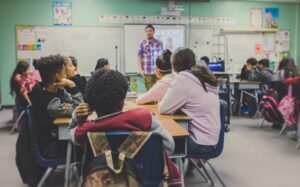
When we talk about student success, it’s easy to fall into a trap: defining learners by their deficits. But what if the real issue isn’t the learner, it’s the label? What if our system, and the expectations that come with it, are limiting the very students we’re trying to help?
As an educator, consultant, and parent of a child with learning differences, I’ve seen firsthand that when we shift how we view student potential, and provide differentiated instruction, everything changes. It’s not about doing more; it’s about doing different. And it’s not just for “special ed” or struggling learners, these strategies are good for all students, and critical for different learners.
From Labels to Learners: Changing the Narrative
Early in my teaching career, I noticed something troubling. Many of the students identified as “special needs” weren’t struggling because they lacked ability, they were struggling because traditional teaching methods didn’t match their learning preferences. Too often, we were teaching to one type of learner: those that have excellent language based and auditory memory skills. Everyone else was left behind.
My son has Central Auditory Processing Disorder as well as a form of dyslexia. I was told more than once in his school life that he did not belong in honors classes, that he was an overachiever and shouldn’t be where he is; and one teacher went as far as to say that if he continued to push himself so hard to achieve beyond his ability level that he may end up in a mental institution. But with strategic interventions, vision therapy, immersive summer programs, academic coaching, he graduated with a degree in mechanical engineering and now works as a design engineer.
So, I have a mother’s perspective of how students are often limited because of teacher expectations versus their own motivation. His story isn’t unique. It’s a testament to what’s possible when we stop limiting students with labels and start believing in their ability to thrive.
The Power of Personalized Learning
Personalized learning requires a mindset and a methodology that enables all students to succeed in the same classroom. It doesn’t mean watering down the content. It means varying how we teach, what we ask students to do, and how we assess them, based on their readiness levels, interests, and learning profiles. Most importantly, it requires students to learn how they learn.
Here’s what personalized learning looks like in practice:
- Offering Choice: Let students choose the order of tasks or how they demonstrate learning. This builds ownership and motivation.
- Teaching Strengths: Incorporate visual, auditory, kinesthetic, and interpersonal elements into your lessons. When we teach using graphic organizers, color-coding, and movement activities, we engage more learners and accelerate growth.
- Flexible Grouping: Mix students based on skill, interest, or learning style. This fosters peer learning and helps everyone find a place to shine.
- Formative Assessment & Feedback: Use check-ins and exit cards to adjust instruction in real-time, ensuring no one gets left behind.
Personalized learning doesn’t mean crafting twenty different lesson plans for twenty students. It’s about using thoughtful strategies that connect with a wide range of learners all at once.
Empower Through Self-Regulation
One of the biggest game changers for struggling learners is teaching them how to self-regulate, not just behavior, but their own learning.
Self-regulated learners:
- Set clear goals (both academic and process-based)
- Use strategies to manage time and monitor progress
- Reflect on what works and adjust accordingly
This kind of autonomy is what moves a student from struggling to thriving. And yes, it takes time, but the payoff is massive.
Start with simple strategies:
- Rehearsal (mnemonics, acronyms, rhymes)
- Elaboration (make it real, personal, and connected to prior knowledge)
- Organization (color-coded notes, visual roadmaps, and chunking information)
These are not just tools. They’re lifelines.
Let’s Stop Underestimating Kids
Before inclusion became the norm, I taught self-contained special education classes. We dumbed down the curriculum because we didn’t know better. I was doing the right thing, giving students something they could handle.
But I was wrong.
Once we integrated students with learning differences into general education classrooms, something incredible happened: They rose to the occasion. With proper support and high expectations, they learned more than we ever thought possible.
Students don’t need less. They need more opportunity, more belief, and more access to quality instruction.
Conclusion: Every Student Can Learn
What I’ve learned after decades of teaching, parenting, and consulting is this: Struggling learners don’t need to be fixed. They need to be understood. When we teach with intention and differentiate with purpose, we open the door to success for every child in the room.
Our job as educators is to believe in our students, even when they don’t believe in themselves yet. Especially then.
Let’s stop labeling students by what they can’t do. Let’s start teaching them in ways that let them show what they can do.
Call to Action
If this article resonates with you, you’re not alone, and you don’t have to figure it all out by yourself. Whether you’re a classroom teacher, instructional coach, or administrator, I offer dynamic in-person trainings and consultations that bring these strategies to life.
✅ Book me for a school in-service or district PD
✅ Explore my blog for hundreds of free articles that support students, parents, and educators.
✅ Pick up your copy of Special Needs in the General Classroom for 500+ ready-to-use strategies
Let’s work together to move students from surviving to thriving, one strategy at a time.
🔗 Visit www.susanfitzell.com to get started.
 |
CLICK HERE to discover a wealth of teaching strategies and resources for maximizing student success!.
Bring Susan to your campus!Featured seminar – Differentiation Strategies to Reach ALL Learners in the Inclusive Classroom |
